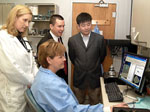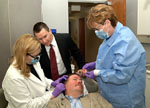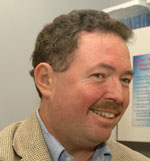MUSC, Clemson team up to improve
outcome of
prosthetic ears, noses
by Mary
Helen YarboroughPublic Relations
Gary Reeves never got used to having only one ear. At 43, the Baptist minister, who was born without a right ear, still cringed at the questions and stares and was hurt by children’s comments.
Urged by his sister, who works in the College of Medicine’s dean’s office, the Conway man came to MUSC in 2004 to do something about it.
Reeves’ plight coincided with a collaborative project between MUSC and Clemson University (CU) to develop revolutionary ways to replicate and replace a missing or lost feature, such as an ear or nose.
Now, Reeves is a living example of the close collaboration between engineering and a medical school in implementing new medical technologies in a clinical setting.
 Dr. Betsy Davis,
from left, Randy Emert and Dr. Hai Yao watch Kathy Hood demonstrate
imaging technology.
Dr. Betsy Davis,
from left, Randy Emert and Dr. Hai Yao watch Kathy Hood demonstrate
imaging technology.In 2003, CU and MUSC began a joint bioengineering program that pooled resources, knowledge and talents of both institutions to better serve the citizens of South Carolina. This technology is a joint effort by the MUSC Department of Otolaryngology and Head & Neck Surgery and the departments of General Engineering and Bioengineering at CU.
Reeves first saw Betsy Davis, DMD, and Durwood Bach, DDS, about a prosthetic implant retained ear prosthesis. He previously had surgical reconstruction of the defect earlier in his life that had failed. As part of the treatment planning process, Reeves was evaluated by surgeons Adam Ross, M.D., about another surgical reconstruction; and Paul Lambert, M.D., on his hearing loss. After carefully reviewing his options, he decided to proceed with the implant- retained ear prosthesis.
Meanwhile, Davis, who also is director of the Division of Maxillofacial Prosthetics, was lecturing at CU on osseointegration biomechanics. At that time, she met Randy Emert, a Clemson professor who wanted to become more involved in the medical imaging field.
“I approached Professor Emert at Clemson about solving a clinical problem, in this case a missing ear, which would result in a saving of time and cost for the patient,” Davis said. “We then had an imaging and medical team working together to solve the problem.”
 Davis, Emert and
Hood work with Gary Reeves and his new prosthetic ear.
Davis, Emert and
Hood work with Gary Reeves and his new prosthetic ear.The resulting method and technology combines the use of existing software, medical imaging using 64-slice CT scanning, and rapid prototyping.
It saves about 75 percent of the time compared to other methods. It saves money, and the process is virtually painless since it does not require the traditional impression.
Whereas traditionally prosthetic fabrication involves sculpting from wax, the medical imaging and rapid prototyping are used to create a replica of the patient’s anatomy. The fit is natural and almost seamless, said Emert, who teaches engineering graphics and developed the method.
The resulting process developed by MUSC and CU engineering collaboration means the creation of prosthetic ears and noses that are the same shape as the contralateral ear or, in the case of the nose, the exact shape of the nose prior to removal.
Led by Emert and Davis, the process employs medical imaging software and rapid prototyping technology to re-create features lost by birth defects, burns, cancer or accidents. For Reeves, having a natural-looking prosthetic ear is a blessing.
“I just started telling people an alligator bit it off,” said Reeves. “I never did adjust to not having an ear. I’d get stares, and kids pick up real quick.”
 Gary Reeves with
his new ear.
Gary Reeves with
his new ear.But now, after having a natural-looking ear that nature had left vacant, he said he is relieved. “I feel more comfortable in public. It’s a godsend,” he said. “My wife has a hard time knowing which ear I can hear out of. …And now, if somebody asks me how I play the piano, I say by ear.”
Davis said that had Reeves chosen to do so, surgeons could have opened the ear canal, which remains closed from birth. But Reeves said he has grown accustomed to not hearing out of that side of his head.
The ear, which was carefully crafted and painted, resembles an ear matching his complexion, and is attached to two small posts that were anchored to Reeves’s skull by Bach, chair of MUSC’s Department of Oral and Maxillofacial Surgery.
Then, Kathy Hood, an anaplastology technician, added the proper dyes and put the final touches to the silicone prosthetic so that it appears natural.
Specifically, the CU/MUSC technology uses the shape of his left ear from his CT scan, then the Mimics graphics program images the shape to the missing ear and then builds the shape, layer by layer, producing an electronic file from which a wax pattern is built. After that, the wax ear is then transferred to silicone and color and details down to the tiny red veins, are added to present a real-life replica. To the touch, it is as close to flesh as could be possible.
To date, one prosthetic ear and a nose have been made.
Davis said the technology was used to rebuild a nose for a patient who had cancer. In this case, once a person has been diagnosed with cancer that will require the removal of the nose, the pre-operative CT scan is used to recreate the shape of the nose. It then will be “imaged” to the post-operative CT scan, and the wax pattern is made by rapid prototyping.
Future plans with the imaging program include making a surgical template for placement of implants and fabrication of the implant bar and prosthesis before surgical resection.
“Our ultimate goal is to have the bar and prosthesis ready at the time of surgical resection so that patients are able to be rehabilitated at the time of surgical resection,” Davis said. This minimizes the psychological trauma from losing a facial feature that is critical to identifying who we are, she added.
Davis also works with Clemson bioengineering faculty members permanently positioned at MUSC. Among them is Hai Yao, Ph.D., who is an expert in biomechanics and tissue engineering. With Yao’s assistance, future projects include fracture toughness of ceramic materials, implant surface configurations and rebuilding jaw bones and tissue engineering.
This collaboration also has resulted in a promising venture with a company to develop technology used in the automobile industry and apply it to medical applications. “The purpose is to integrate medical applications into the biomedical research side,” Emert said.
Yao, Davis, and Emert expressed appreciation for the support they have received from CU, in particular Martine LaBerge, Ph.D., chair of the Department of Bioengineering; Larry Dooley Ph.D., associate dean of Research and Graduate Studies; and Richard Swaja,Ph.D. MUSC’s Center of Economic Excellence Chair for Regenerative Medicine, professor of cell biology and anatomy, professor of engineering at Clemson University and an adjunct professor with the University of South Carolina. In addition, their efforts are supported from MUSC’s Lambert and Terry Day, M.D., from the College of Medicine and Hollings Cancer Center, and Steve London, DMD, Ph.D. from the College of Dental Medicine.
Friday, Feb. 2, 2007
Catalyst Online is published weekly,
updated
as needed and improved from time to time by the MUSC Office of Public
Relations
for the faculty, employees and students of the Medical University of
South
Carolina. Catalyst Online editor, Kim Draughn, can be reached at
792-4107
or by email, catalyst@musc.edu. Editorial copy can be submitted to
Catalyst
Online and to The Catalyst in print by fax, 792-6723, or by email to
catalyst@musc.edu. To place an ad in The Catalyst hardcopy, call Island
Publications at 849-1778, ext. 201.